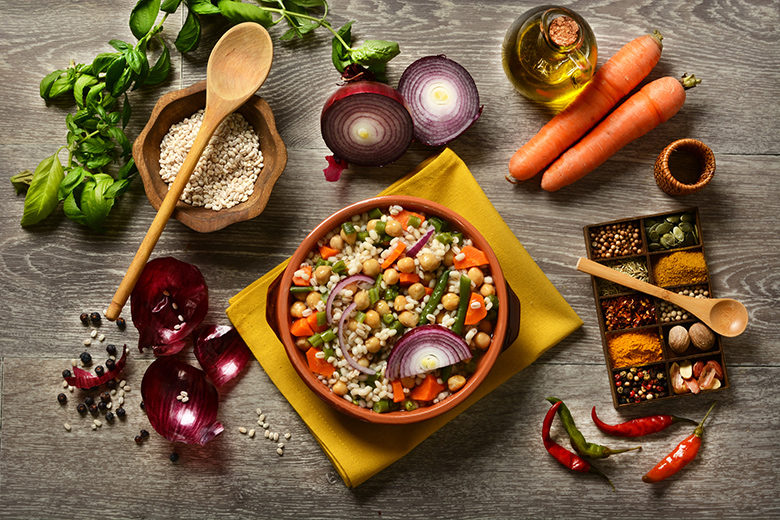
For people with diabetes, blood sugar values are forever on their minds. What food to eat? How much to eat? When to snack? When to exercise? How will my choices affect my blood sugar? Often forgotten are other equally important health parameters such as blood pressure and cholesterol levels. Food and activity affect these important measures, too.
According to both the American Diabetes Association and the American Heart Association, many people with diabetes don’t realize that their risk for heart disease is at least double that of someone who does not have diabetes. For this reason, people with diabetes must make food choices that support the heart as well as help to manage blood sugar.
Here are a few diabetes-friendly and heart-healthy foods to eat often. Some are carbohydrate-rich, so read labels or search the Internet to learn how many grams of carbohydrate are in your portion. Count these toward your totals for meal-planning purposes.
Beans
Rich in fiber, potassium, magnesium, folate and several health-boosting phytochemicals, beans are linked to lower blood pressure and reduced risk of heart disease. Eating at least four servings of beans per week lowers the risk of coronary heart disease by 22 percent, according to a 2001 study in the Archives of Internal Medicine. Rinse canned beans to lower their sodium content by about 40 percent.
To get more beans into your diet:
- Add canned beans to any favorite soup or on top of a green salad.
- Thicken traditional chili or a favorite soup with a can of mashed cannellini beans.
- When the weather turns cool, warm up with a three-bean chili.
- Extend your ground meat by mixing it with lentils.
Oats and Barley
These grains contain beta-glucan, a fiber that acts like a sponge, sopping up cholesterol from your digestive tract and preventing it from entering your bloodstream. This same fiber helps control blood glucose. too.
To get more oats and barley into your diet:
- Cook up a barley pilaf in place of rice pilaf.
- Create your favorite pasta salad recipe with barley instead of pasta.
- Thicken soups and stews with oats.
- Mix oats into your ground meat when making meatballs or meatloaf.
- Swap 1/3 of the flour with oats in recipes for muffins, breads and cookies.
Fish
Fatty fish like salmon, lake or rainbow trout, herring, anchovies, sardines, albacore tuna and tuna steaks are jam-packed with heart-shielding omega-3 fatty acids. The American Heart Association advises us to eat fish at least twice weekly.
To get more fish into your diet:
- Top your favorite fish with lemon, garlic and fresh basil or with a fruit salsa.
- Add salmon or canned sardines to a green salad for a main dish.
- Use canned salmon to make salmon salad or baked salmon cakes.
- Toss tuna from a pouch with pasta and vegetables for a quick main-dish pasta salad.
Nuts
Nuts give us healthy fats, protein, fiber, minerals and vitamins. The British Journal of Nutrition published evidence that eating nuts at least four times a week may lower your risk of developing heart disease by 37 percent. Walnuts pack a healthy dose of omega-3 fatty acids.
To get more nuts into your diet:
- Sprinkle some over salads.
- Top steamed green beans with toasted sliced almonds.
- Spread peanut butter and other nut butters on whole grain bread or crackers or dab some on banana or tart apple slices.
- Add chopped pistachios or walnuts to chicken salad.
Berries
The blues and reds of berries indicate the fruits’ rich anthocyanin content. That’s good news to your heart because anthocyanins have been found to be helpful in controlling inflammation associated with heart disease.
To get more berries into your diet:
- Add berries to smoothies and to hot and cold cereals.
- Combine your favorite berries, nuts, salad greens and small pieces of goat cheese for an innovative salad.
- Top a bowl of fresh berries with a few cake crumbs or a dollop of frozen yogurt instead of topping a larger serving of cake or frozen yogurt with a few berries.
Tea
Research in the European Journal of Clinical Nutrition suggests that drinking tea is associated with a reduced risk of heart attack. And the journal Food & Function published a study suggesting drinking tea is associated with lowering of high blood pressure and improved cholesterol levels. Tea provides phytochemical disease fighters, especially flavonoids.
To get more tea into your diet:
- Keep your calorie-free and carb-free beverage diabetes-friendly by drinking tea without sugar or honey.
- Skip the bottled teas. They have little, if any, flavonoids.
- Brew your tea in hot water. If you prefer iced tea, brew it extra strong.
Happy, healthy eating!











